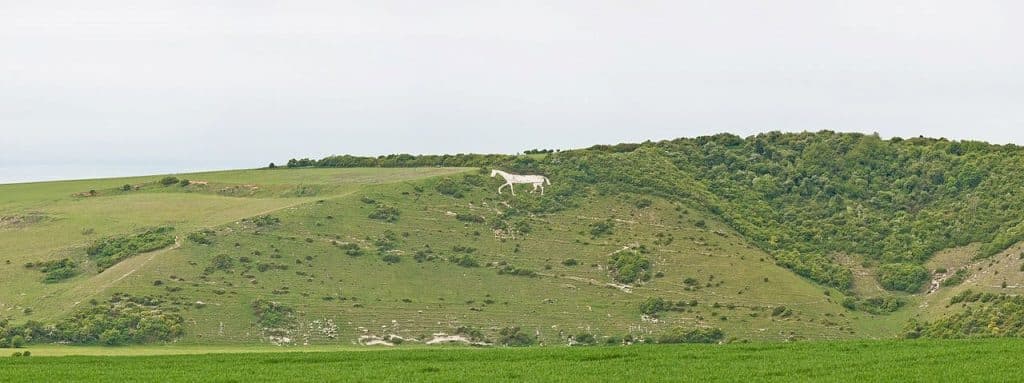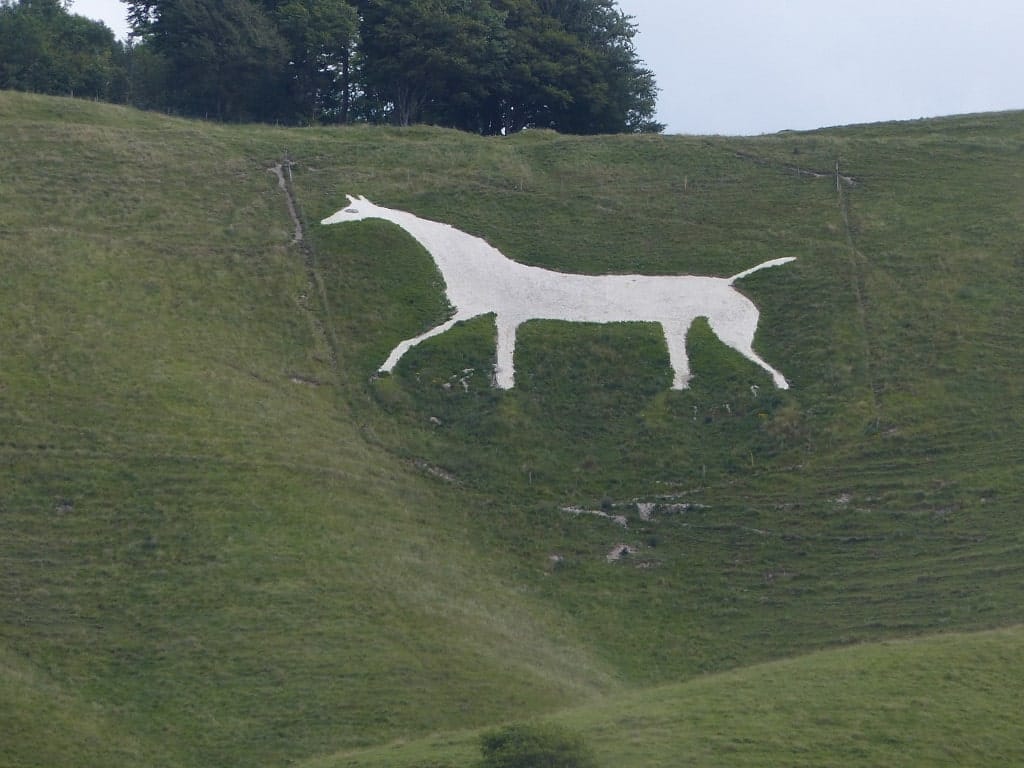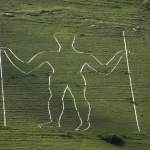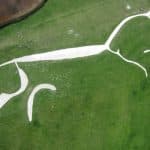Last Updated on 14/04/2023 by Alex Hamlyn
Table of Contents
Where is the Litlington White Horse
A Picturesque Location in the British Countryside
The Litlington White Horse is situated in East Sussex, in the South Downs National Park. This beautiful and tranquil location offers stunning views of the surrounding countryside. The site is in close proximity to other ancient sites, such as the Long Man of Wilmington and the Lewes Priory ruins, making it an ideal destination for history enthusiasts.
Unravelling Ancient Sites in the British Isles
Britain is a land steeped in history. It has witnessed the rise and fall of numerous civilisations. From the ancient Britons to the Romans, Anglo-Saxons, and Vikings, this island has been home to diverse cultures that have left their mark on its landscape.
The British Isles have became a treasure trove of ancient sites that provide a glimpse into the lives and beliefs of the people who once inhabited them. Stonehenge, the iconic stone circle, and the ancient Neolithic village of Skara Brae in the Orkney Islands, are just a few examples of these fascinating archaeological wonders.
The Litlington White Horse: A Wonder, but not Ancient
The Litlington White Horse is a unique site located in the United Kingdom. It is a hill figure, a large geoglyph, carved into the chalky hillside, depicting a horse. This stunning creation is one of several white horses found across Britain, such as the Uffington White Horse and the Westbury White Horse.
The most curious fact about the Litlington White Horse is that it is, in fact, not that ancient, and the one we see on the South Downs today isn’t even the original. More details on that later…
The Horse in Ancient British Culture
The horse was highly regarded in ancient British culture, playing a vital role in the lives of the people and shaping their beliefs and traditions. Its importance can be observed across various aspects of ancient life, from warfare and transportation to religious symbolism and mythology.
White horses, in particular, were considered sacred and were often associated with the gods and goddesses of the Celtic pantheon. The Litlington White Horse, as well as other similar hill figures, likely served as symbols of spiritual protection, territorial markers, or even as tributes to deities.
Warfare and Transportation
In ancient Britain, horses were essential for warfare and transportation. They provided speed and agility on the battlefield, enabling swift attacks and rapid retreats. The Celts, in particular, were renowned for their horsemanship and mastery of cavalry tactics. The importance of horses in warfare is evident in the remains of high-ranking warriors, who were often buried with their horses as a sign of their status and power.
Additionally, horses played a crucial role in facilitating trade and communication between different settlements and tribes. They were used to transport goods and people over long distances, helping to forge connections and foster relationships between communities.
Religious Symbolism
Horses were deeply ingrained in the religious beliefs and practices of ancient Britons. They were associated with various gods and goddesses, symbolising power, fertility, and swiftness. For example, the Celtic goddess Epona, who was revered across the Celtic world, was often depicted riding a horse or surrounded by horses. As protectors of horses and horsemen, she was invoked for safety during travel and to ensure fertility and abundance in the fields.
Similarly, Rhiannon, a prominent figure in Welsh mythology, is also closely associated with horses. She is described as a beautiful woman who rides a white horse and possesses magical powers. Horses were often sacrificed in religious rituals, further emphasising their spiritual significance in ancient British culture.
Art and Iconography
The prominence of the horse in ancient British culture is reflected in the art and iconography of the time. Horses frequently appear on coins, pottery, and metalwork, often depicted alongside human figures or in scenes of battle or hunting. In addition to the hill figures like the Litlington White Horse, Uffington White Horse, and the Westbury White Horse, horses have also been found carved into stone monuments, such as the Pictish symbol stones in Scotland.
These artistic representations of horses demonstrate how the horse held a significant place in ancient British culture, playing a vital role in various aspects of life, from warfare and transportation to religious practices and artistic expression. Its symbolism and importance can still be seen today in the many ancient sites and artefacts that bear witness to the enduring legacy of the horse in the history of the British Isles.

The Intriguing Story Behind the Litlington White Horse
The true story of the origin of the Litlington White Horse is unclear. We know it was created in 1838 by a local resident named James Pagden, and it is believed that Pagden was inspired to commemorate the the coronation of Queen Victoria.
This story is first recorded in the Sussex Advertiser in 1838, which reported on the creation of the figure and the festivities that accompanied its completion. It’s also possible Pagden could also have been inspired by the nearby Uffington White Horse which dates back to the bronze age. However, another story dating to 1860 tells how two boys found a patch of bare chalk which resembled a horses head and so completed the image we see today.
Maybe both stories are correct, and the boys in 1860 uncovered the original horse made by Pagden which had since been neglected.
Local folklore gives us two more origin stories. The first being the tale of a girl whos horse bolted on the hill and throwing her to her death. The second is that the original figure was not a horse but a dog, cut into the hillside by a grieving child. Erosion led to the carving resembling the horse we see today.
There’s no evidence for either of these stories, and in any event, by the early 20th century, the horse had been neglected again, and the last recorded sighting was in 1912.
In 1924 a new horse was carved into the hillside near, but not on, the original location. This new Litlingotn horse was desiend by John Ade in the previous year, and was carved in one night under a full moon with the help of some friends.
The horse was covered and hidden during the second world war when it was learned that German air crews were using hill sites like this as navigation aids. In 1945 when it was uncovered again, one of the legs was damaged. This was restored in 1949 by John Ade, again under a fulll moon.
Protective works to preserve the horse were added in the 1980s, and it was again recarved into a different position in order to prevent challk slippage.
Since then, the White Horse has been maintained by local volunteers, ensuring that it remains a prominent and enduring feature of the landscape. Their most recent concern was removing a unicorn horn from the horse’s head in 2017.
Conclusion
The Litlington White Horse today deserves is place among the ancient hill figures of Britain, even if it much younger than the others. It still holds a place in British culture and is today protected and maintained by the National Trust.
If you’re in the area for a walk along the beautiful South Downs, be sure to stop by.
Image credits
- Litlington White Horse – By Schildiecom – Own work, CC BY-SA 4.0, https://commons.wikimedia.org/w/index.php?curid=42184158
- Litlington White Horse from a distance – By Diliff – Own work, CC BY-SA 3.0, https://commons.wikimedia.org/w/index.php?curid=6739885
References
- https://en.wikipedia.org/wiki/Litlington_White_Horse
- https://www.atlasobscura.com/places/litlington-white-horse
- https://www.sussexlive.co.uk/news/sussex-news/story-behind-giant-white-horse-5573524
- https://theoutdoorguide.co.uk/walks/national-parks/white-horse-walk-south-downs/
- https://www.alltrails.com/en-gb/trail/england/east-sussex/litlington-white-horse-cuckmere-river-circular
- https://www.megalithic.co.uk/article.php?sid=19771



